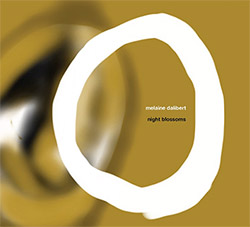
Night Blossoms is formed of tracks that were recorded by Dalibert across a three-year period. The first two tracks, 'a rebours' and 'windmill' (all the song names are stylized in lower case letters) were recorded in 2019. Both 'eolian escape' and 'sisters' were recorded in 2020, and 'yin' and 'yang' were recorded in 2021. Notably, 'yin' and 'yang' feature contributions from the ambient and minimalist stalwart David Sylvian.
The track 'a rebours' shares its name with an infamous fin de siècle novel. In the novel, the narrator — a disillusioned and misanthropic nobleman — recalls their various hedonistic endeavors. As the novel progresses, we learn that the narrator is an aesthete, who is someone that gives total primacy to sensibility and aesthetics. Value itself, for an aesthete, supervenes on aesthetic experience. Fittingly, Dalibert's 'a rebours' is a decadent piece. Tentative musings evolve into emboldened retrograde sequences. These sequences, which are interwoven with ringing atonal delays, form an opulent tonal tessellate. When listening to this song, I cannot shake the image of some supine, catatonic aesthete nodding their head and waving their hand to it. Contrasting 'a rebours' (the aesthete's national anthem), we have 'windmill,' in which soporific sequences are replaced by something more effervescent — more alive. Swathes of Lydian scales climb and clamber over one another. Metronomic low notes attune these fluttering rhythms, accentuating the vicissitudes of tone.
In 'yin' and 'yang,' we see Dalibert and Sylvian working in tandem. Both of these tracks consist of notes from only one pentatonic mode: 'yin' consists of notes from the pentatonic mode of F-sharp, whereas 'yang' consists of notes from the pentatonic mode of C. Despite this restricted domain, Sylvian's embellishments allow scarcity and paucity to feel full and effusive. Using ideas redolent of his work in When Loud Weather Buffeted Naoshima, Sylvian's "electronic shadows'' lend extension and depth to otherwise beleaguered sounds; notes hang and loom like sonic stalactites, with movements that cast ripples and waves throughout the mix.
Unlike the first three songs, the last three songs are not played on a muted piano. As such, during the second half of Night Blossoms, one becomes aware that the various rhythmic interplays are not as cohesive as before; there is an incipient sense of sonic conflict and harmonic dissonance. This comes to a head in 'sisters,' which is the track sandwiched between 'yin' and 'yang.' Taking the form of a canon, voices dance in and out of phase with one another. This track takes the form of both grand polyrhythmic swells, where the individual voices all coalesce seamlessly, and moments of atonality, where notes jostle and jolt one another.
Through Night Blossoms, Dalibert dissects the notion of tone. On the one hand, we have the piquant tones created by Dalibert's deftly orchestrated scales and movements. On the other hand, we have the inimical tones created by Sylvian's modulations of Dalibert's more forlorn and languid playing. In both cases, listeners will find themselves like the hypothetical aesthete I posited earlier, nodding their heads and waving their hands to each track.
Comments and Feedback:



More Recent Reviews, Articles, and Interviews @ The Squid's Ear...


|

